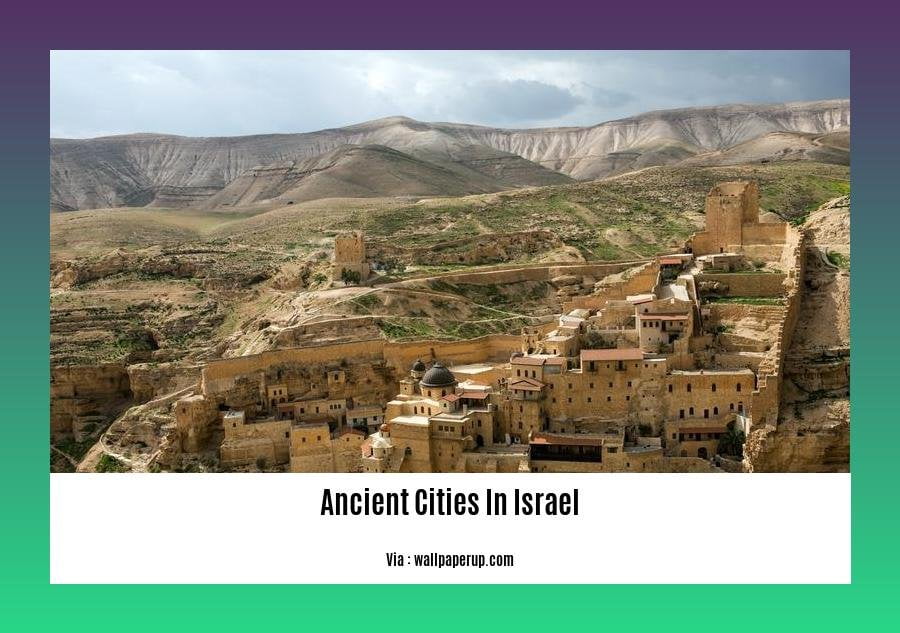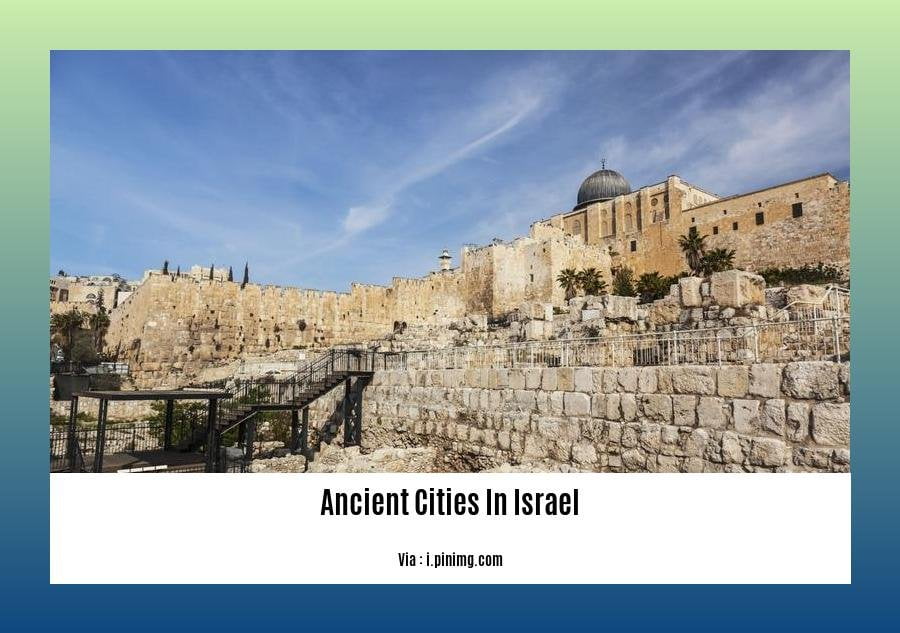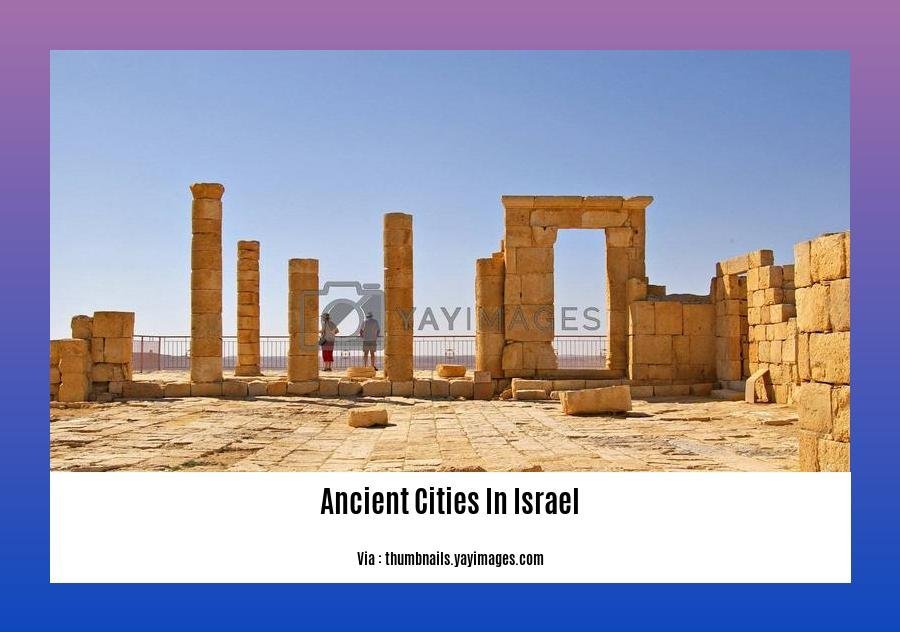Embark on a captivating journey through time as we delve into the enigmatic allure of ancient cities in Israel. Unearth the secrets of these long-lost civilizations, deciphering their captivating stories through the remnants of their architectural wonders, artifacts, and inscriptions. Join us on this archaeological odyssey as we piece together the puzzle of their existence and uncover the profound legacy they left behind. Prepare to be transported to a world of mystery, wonder, and historical significance – [A Journey Through Time: Unraveling the Enigma of Ancient Cities in Israel] awaits.
Key Takeaways:
- Israel possesses a long and rich history extending back to ancient times.
- Numerous ancient cities are located throughout the country, each holding a distinct history and culture.
- Excavations in these cities have unearthed many artifacts that provide insight into ancient civilizations.
- The ancient cities of Israel are popular destinations for tourists, offering a glimpse into the nation’s past.
- Caesarea, Yad Vashem, Masada, Rabin Square, and the City of David are popular ancient cities in Israel with unique stories and cultures.
Ancient Cities in Israel: A Saga of History, Culture, and Enduring Significance

[ancient cities in Israel] offer a captivating glimpse into the region’s storied past. These urban centers, each boasting a unique identity, were once bustling hubs of commerce, culture, and religious observance.
Jerusalem: The Eternal City’s Enduring Legacy
Jerusalem, the “City of Peace,” stands as a testament to Israel’s rich history and spiritual significance. Throughout the ages, it has been revered as a holy city by Judaism, Christianity, and Islam.
Caesarea: A Roman Port City’s Grandeur
Caesarea, once the capital of Judea during the Roman Empire, is a marvel of ancient engineering and urban planning. Its magnificent harbor, amphitheater, and hippodrome are a testament to the city’s grandeur.
Masada: A Mountaintop Fortress of Epic Proportions
Masada, perched atop a mountain overlooking the Dead Sea, is a symbol of resilience and defiance. This ancient fortress was the last stronghold of Jewish rebels during the First Jewish-Roman War.
Ruins That Whisper Tales of Bygone Eras
[ancient cities in Israel] offer an open-air museum of ruins and artifacts, whispering tales of civilizations long past. Visitors can explore the remnants of synagogues, churches, mosques, and palaces, each with its own story to tell.
Preserving and Honoring Israel’s Ancient Heritage
These [ancient cities in Israel] are not mere relics; they are living testaments to the region’s enduring spirit. Preserving and appreciating these sites is paramount to understanding and honoring the rich tapestry of Israeli history and culture.
Embark on a virtual voyage to ancient Italy by clicking on ancient buildings in Italy, where you will discover stories and secrets hidden within each monument.
Transport back in time to ancient China and uncover the mysteries of their ancient recipes from ancient china recipes , which still tantalize taste buds today.
Delve into the enigmatic lore of ancient china symbols , deciphering meanings that carry wisdom and cultural significance across the ages.
Cultural and Religious Significance of Ancient Cities
Unraveling the enigmatic tapestry of ancient cities in Israel takes us on a mesmerizing journey through time, revealing the profound cultural and religious significance that has shaped this region for millennia. From the holy city of Jerusalem to the iconic ruins of Masada, these ancient urban centers stand as testaments to the vibrant civilizations that once flourished here, leaving an indelible mark on history.
Jerusalem: A Crossroads of Faiths
Jerusalem, a city revered by Judaism, Christianity, and Islam, radiates an aura of sanctity that captivates pilgrims and visitors alike. Its hallowed grounds encompass the Western Wall, a remnant of the Second Temple, where prayers and supplications ascend heavenward. The Church of the Holy Sepulcher, believed to be the site of Jesus’ crucifixion and resurrection, draws devout Christians from around the world. The Dome of the Rock and Al-Aqsa Mosque, perched atop the Temple Mount, are emblems of Islamic heritage, symbolizing the Prophet Muhammad’s Night Journey.
Cultural Diversity: A Tapestry of Traditions
The ancient cities of Israel were cultural melting pots, where diverse ethnicities and traditions intertwined, giving rise to a rich tapestry of customs and beliefs. In Jerusalem, Jews, Christians, and Muslims lived side by side, each practicing their faith while engaging in commerce, scholarship, and artistic pursuits. Akko, a bustling port city, teemed with Greek, Roman, and Phoenician influences, reflected in its architecture, cuisine, and language. Caesarea, built by Herod the Great, showcased Roman grandeur, with its amphitheater, aqueduct, and hippodrome. Archaeological excavations in these cities have unearthed a treasure trove of artifacts, shedding light on their cosmopolitan nature and the vibrant cultural exchange that took place.
The Enduring Legacy of Ancient Israel
The ancient Israelites played a pivotal role in shaping the cultural and religious landscape of the region. Their monotheistic beliefs, enshrined in the Torah, set them apart from the polytheistic practices of their neighbors. The Israelites established a unique covenant with God, characterized by moral and ethical teachings that emphasized justice, compassion, and the sanctity of life. These teachings, embodied in the Ten Commandments, formed the foundation of their legal and social systems, leaving a lasting impact on Western civilization.
Key Takeaways:
Jerusalem, a holy city for Judaism, Christianity, and Islam, attracts pilgrims and visitors from around the world to its sacred sites like the Western Wall, the Church of the Holy Sepulcher, and the Dome of the Rock.
Ancient cities like Jerusalem, Akko, and Caesarea were cultural melting pots, where diverse ethnicities and traditions converged, leading to a rich tapestry of customs and beliefs.
Archaeological discoveries in these cities reveal their cosmopolitan nature and the vibrant cultural exchange that took place, reflecting Greek, Roman, and Phoenician influences.
The ancient Israelites made a significant contribution to the cultural and religious landscape of the region with their monotheistic beliefs, moral teachings, and unique covenant with God.
The enduring legacy of ancient Israel can be seen in the influence of its teachings on Western civilization, emphasizing justice, compassion, and the sanctity of life.
Relevant URL Sources:
- Ancient Israel: Religion, Culture, and History:
- 8 Must-See Old Cities in Israel:
Architectural Marvels and Monuments

Israel’s ancient cities are a living testament to the ingenuity, artistry, and cultural diversity that have shaped this region for millennia. As an archaeologist, I’ve spent years exploring these fascinating sites, uncovering secrets that tell the story of a land where history and legend intertwine. Join me on a journey through time as we discover the architectural marvels and monuments that reveal the essence of ancient Israel.
H3: A Tapestry of Architectural Styles
From the towering walls of Jerusalem to the intricate mosaics of Masada, Israel’s ancient cities showcase a breathtaking array of architectural styles. These structures reflect the diverse influences that have shaped the region, from the grandeur of the Romans to the delicate artistry of the Byzantines.
H3: Symbols of Power and Faith
Many of Israel’s ancient architectural marvels were built as symbols of power and faith. The Western Wall, a remnant of the Second Temple, is the holiest site in Judaism. The Dome of the Rock, with its golden dome, marks the spot where the Prophet Muhammad is believed to have ascended to heaven. These monuments stand as testaments to the deep religious and cultural significance of this land.
H3: Preserving the Past
Today, Israel’s ancient cities are carefully preserved, offering a glimpse into the region’s rich history and cultural heritage. Visitors can walk through the streets of ancient Jerusalem, marveling at the Roman Cardo, or explore the ruins of Caesarea, once a thriving port city. These sites serve as open-air museums, inviting us to connect with the past and appreciate the enduring legacy of ancient Israel.
Key Takeaways:
Israel’s ancient cities showcase a diverse array of architectural styles, reflecting various cultural influences.
Many architectural marvels were symbols of power and faith, embodying the religious and cultural significance of the region.
Today, these ancient cities are preserved as open-air museums, offering a glimpse into Israel’s rich history and cultural heritage.
Relevant URL Sources:
Encouraging Tourism and Preservation Efforts
Throughout time, the ancient cities of Israel have been whispering stories of long-lost civilizations, religious zeal, and cultural tapestry. From the holy city of Jerusalem to the bustling port of Jaffa, these urban centers hold clues to our shared history. Their preservation and accessibility are paramount not only for their intrinsic value but also for fostering understanding, appreciation, and encouraging tourism.
Key Takeaways:
Harnessing the past to shape the future: Ancient cities offer a glimpse into our collective roots, providing vital context for understanding the present and charting a path for the future.
A window into diverse heritage: Israel’s ancient cities showcase a rich tapestry of cultures, religions, and architectural styles, inviting visitors to delve into a world of diverse heritage.
Promoting sustainable tourism: Preserving and maintaining ancient cities requires responsible tourism practices that minimize environmental impact and ensure the long-term health of these sites.
Economic benefits: Encouraging tourism to ancient cities can stimulate local economies, create jobs, and provide opportunities for entrepreneurship, particularly in rural or marginalized regions.
Fostering cross-cultural understanding: By exploring ancient cities, visitors gain insights into different ways of life, promoting empathy and understanding among people from all walks of life.
Strategies for Encouraging Tourism and Preservation Efforts:
Infrastructure and Accessibility: Invest in infrastructure development, such as transportation networks and visitor centers, to make ancient cities more accessible to tourists.
Collaborative Partnerships: Establish partnerships between government agencies, local communities, and private sector stakeholders to ensure the sustainable management and promotion of ancient cities.
Educational Programs: Offer educational programs and guided tours that provide visitors with historical and cultural context, enhancing their understanding and appreciation of these historical sites.
Interpretation and Storytelling: Develop interpretive materials and signage that bring ancient cities to life, allowing visitors to connect with the stories and experiences of those who lived there centuries ago.
Community Involvement: Encourage local communities to participate in the preservation and promotion of ancient cities, fostering a sense of ownership and pride in their heritage.
Authentic Experiences: Create authentic experiences for visitors, such as traditional crafts workshops, culinary tours, and historical reenactments, to provide a deeper connection to the past.
Leveraging Technology: Use technology, including virtual reality and augmented reality, to create engaging and interactive experiences that educate and entertain visitors.
By implementing these strategies, we can encourage tourism, foster preservation efforts, and ensure that the ancient cities of Israel continue to captivate and inspire generations to come.
Citations:
The Best Ancient Cities in Israel – Frommer’s
The 12 Must-See Historic Sites in Israel – Fodors Travel Guide
FAQ
Q1: What are some of the most notable ancient cities in Israel?
A1: Among the ancient cities of Israel, Jerusalem, Bethlehem, Akko, Nazareth, Caesarea, Jaffa, and Masada stand out for their historical and cultural significance. These cities have played pivotal roles in shaping the region’s rich tapestry of civilizations and offer a glimpse into Israel’s captivating past.
Q2: Why is Jerusalem considered a particularly sacred city?
A2: Jerusalem holds immense religious significance for Judaism, Islam, and Christianity, earning it the title of a holy city. It is home to revered sites such as the Western Wall, the Church of the Holy Sepulchre, and the Al-Aqsa Mosque. These landmarks attract millions of pilgrims and visitors each year, making Jerusalem a spiritual and cultural hub of global importance.
Q3: What is the historical significance of Caesarea?
A3: Caesarea, once the capital of Judea during the Roman Empire, boasts a rich and storied history. It served as a major port city and administrative center, facilitating trade and commerce throughout the region. Today, Caesarea is a popular tourist destination, renowned for its well-preserved Roman ruins, including an amphitheater and an aqueduct, which provide a tangible connection to the city’s glorious past.
Q4: What makes Masada a unique and captivating historical site?
A4: Masada, an ancient fortress perched atop a mountain near the Dead Sea, is renowned for its dramatic history and resilience. It was the last stronghold of Jewish rebels during the Roman-Jewish War in the 1st century CE. Today, Masada stands as a symbol of Jewish heroism and determination, attracting visitors who come to explore its ruins and learn about the courageous stand made by its defenders.
Q5: How do ancient cities in Israel contribute to our understanding of the region’s cultural heritage?
A5: The ancient cities of Israel serve as invaluable windows into the cultural heritage of the region. They offer tangible evidence of past civilizations, shedding light on the artistic, architectural, and religious practices of the people who once inhabited these lands. By studying these cities, we gain insights into the social, economic, and political dynamics that shaped the region’s history, providing a deeper appreciation for the diverse cultures that have flourished in Israel over the centuries.
- Amazing March Fun Facts: Unveiling History & Celebrations - April 15, 2025
- Master how to write height: A complete guide - April 15, 2025
- How High Are Your Standards Test: Find Your Perfect Match Now - April 15, 2025
















